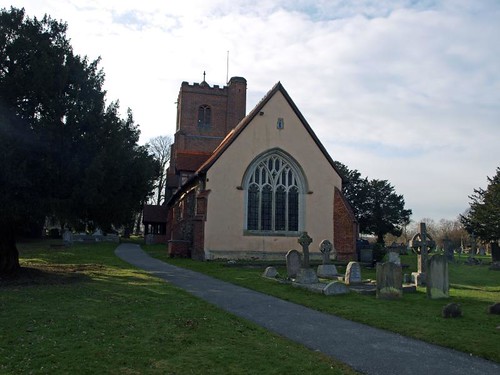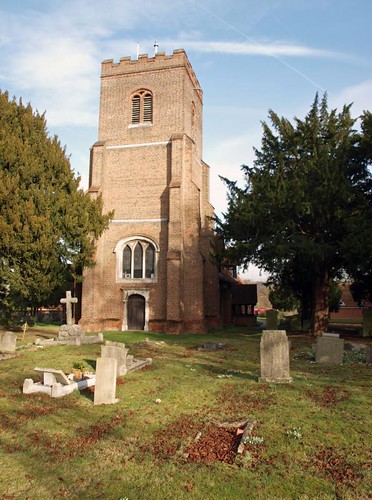Sadly it was locked but a keyholder is listed. Unfortunately I'd wasted so much time finding the place that I didn't have time to track down the keyholder and record the church so I only got exteriors. I must say that despite heavy restoration at some point in its past this is a rather nice church of brick and flint and the setting, if you turn your back on the M25 and tune out the dull roar of traffic, is rather special.
UPDATE: On my way back from Brentwood I went out of my way to revisit but upon calling the keyholder number got a very hostile reception from the man who answered who was very suspicious but eventually said I would have to speak to his wife and passed me over. After explaining, again, why I wanted to view the interior she said that she could come down and unlock the church but that she'd have to wait with me and then lock up and then return home in a tone that said she really couldn't be arsed to go through all that palaver which would utterly ruin her day; so I said don't worry I'll go somewhere else and drove home.
This, to me, was a first. I've been treated with suspicion on several occasions when asking to borrow a church key but normally when the keyholder understands why I want to visit suspicion turns to enthusiasm and even delight that I'm interested in the contents and not intent on robbing them - I've never come across this sort of apathy before. Which leads to a new complaint regarding locked churches - what is the point of listing a keyholder who is too apathetic to open the church when asked? You might as well leave it locked, no keyholder listed.
I was so annoyed that I was going to mark All Saints as LNK but then decided that perhaps she was having a bad day or that something far more pressing than a stranger wanting to visit her parish church was going on in her life that day, so marked it LKL but I wont be re-visiting.
ALL SAINTS. The historical interest of the church lies in the fact that the brick W tower is dated by an inscription (S side) 1520 and the brick N aisle (E gable) 1644. In the tower blue bricks are used as well but apparently without system. W doorway and W window are in all probability of the C18. The original bell-openings have two lights, and there are battlements. The N aisle is also of red brick; the difference between Early Tudor and C17 bricks can be studied. The windows unfortunately are renewed. Of 1644 also is the aisle arcade inside. It is of five bays, entirely of timber, with octagonal piers and round arches. Of the other parts of the church the chancel seems to be C13, see one restored S lancet window. The E window is quite ambitious C15 work. As for the nave the prettiest feature, the two dormers, look Victorian now (restoration 1885), but appear in an illustration in the Gentleman’s Magazine of 1810. - PULPIT with large finely detailed tester, staircase with elegant twisted balusters, and attached Reader’s Desk, c. 1710. - COMMUNION RAIL. With twisted balusters, 1683-4. - PLATE. Cup of 1562, with bands of ornament; Paten C17; two Flagons of 1650; Plate and Paten on foot probably of 1701. - MONUMENTS. Brass to William Kirkeby, rector d. 1458, the figure c. 3 ft long, with engraved orphreys. - Recess in the chancel N wall, containing a tomb-chest with two cusped lozenges on the front. The arch is depressed, a straight horizontal on quadrant curves, and has a quatrefoil frieze above. Kneeling figure of brass of c. 1520 against the back wall. - Similar recess in the chancel S wall, without figures. - Ellen Branch d. 1567, small grey stone tablet with ogee arch. Inside the arch brass plate with kneeling figure. - Several monuments to members of the Archer family. The most spectacular is to William Eyre Archer d. 1739, a standing wall monument with a grey sarcophagus, and a grey obelisk. Two seated cherubs l. and r. of the sarcophagus. Against the obelisk hovers another cherub just above the portrait medallion of the deceased. Unsigned.
THEYDON GARNON. A lonely place in a valley between Epping Forest and Theydon Mount, it has a church hidden in the trees, with only a farm and a cottage or two for company. The church has been here about 700 years, but its high brick tower was built by Sir John Crosby, alderman and grocer of London, and his wife in 1520. The door is as old as the tower itself. The nave is remarkable for having one of the very rare timber arcades in England, five bays in oak, the wooden columns having moulded capitals. It was set here in the reign of Charles Stuart and, with the 15th century roof of the nave, is a veritable triumph of the carpenter. An ironbound chest rests on claw-shaped feet in the vestry, a brass plate with his arms stating that it was given in 1668 by Sir John Archer, a judge. In his memory there is a wall monument on the chancel wall. Facing it on the other side of the lovely east window is an older monument over the grave of Anne, Lady Fitzwilliam, who died a year before Queen Elizabeth, bequeathing to the village the almshouses a few hundred yards away.
Much more beautiful than these classical memorials are two canopied altar tombs in the sanctuary walls. Both are carved in grey marble. One has lost its brasses, but the other has brass portraits of a man in armour with his wife and their five children. There are two other brasses, one of Ellen Branch who died in 1567, and one of William Kirkeby, rector in 1458; he wears a beautiful cope.
Flickr.


No comments:
Post a Comment